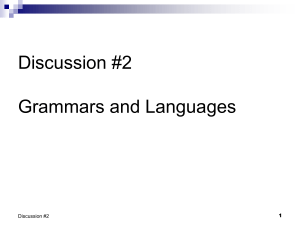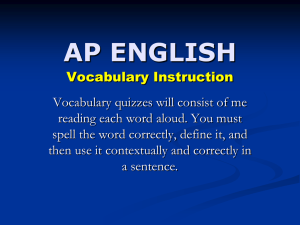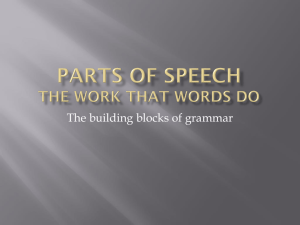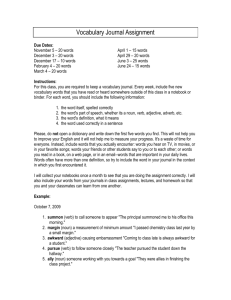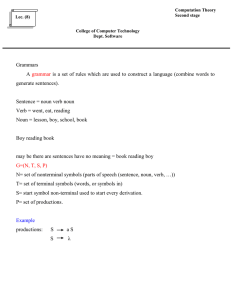Languages, Grammars, and Automata Lecture 2 COT 4420
advertisement
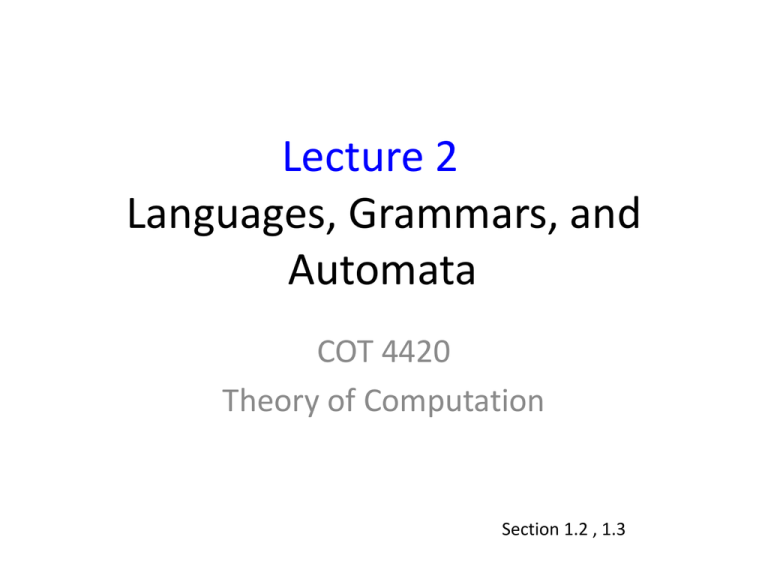
Lecture 2
Languages, Grammars, and
Automata
COT 4420
Theory of Computation
Section 1.2 , 1.3
Languages
Definitions
• Any finite, nonempty set of symbols is an
alphabet or vocabulary.
Σ = {A, B, C, D, …, Z}
Σ = {0, 1}
Σ = { ☐, if, then, else}
• A finite sequence of symbols from the alphabet
is called a string or a word or a sentence.
w = ALPHA
w = 0100011101
Languages
Definitions
• Two strings can be concatenated to form another
string:
v = ALPHA, w = BETA
Concat(v, w) = vw = ALPHABETA
• The length of a string w, denoted by |w| is the
number of symbols in the string.
|ALPHA| = 5
• The empty string is denoted by λ or ε and its length
is 0.
|λ| = 0
Languages
Definitions
• If Σ is the alphabet, Σ* is the set of all strings over
Σ, including the empty string.
• Σ* is obtained by concatenating zero or more
symbols from Σ.
Σ+ = Σ* - {λ}
Let Σ = {a, b, c, d}, what is Σ* ?
Can you specify a procedure to generate Σ* ?
What is |Σ*| ?
Languages
Definitions
• A language over Σ is a subset of Σ*.
L ⊆ Σ*
Example: Σ = {a, b}
L1 = { a, aa, aba}
L2 = { anbn : n ≥ 1}
a finite language
an infinite language
Ways to represent languages
1. Recognition point of view
– Give a procedure which
says Yes for sentences in the language, and
either does not terminate or says No for
sentences NOT in the language.
The procedure recognizes the language
w
M
Yes (accepted)
Ways to represent languages
2. Generation point of view
– Systematically generate (enumerate) all sentences
of the language
• What’s the relationship between these two
points of view?
Given a procedure to recognize L, we can give a
procedure for generating L.
x1
x2
x3
x4
…
Strings
Ways to represent languages
1
1
2
4
7
11
Steps
2
3
3
6
5
9
8 13
12
4
10
14
…
15
1. Run step 1 on x1
2. Run step 1 on x2
3. Run step 2 on x1
4. Run step 1 on x3
5. …
Ways to represent languages
Given a procedure for generating L, we can give
a procedure for recognizing L. what is it?
Definitions
• A language L that can be generated by a
procedure is said to be a recursively enumerable
set or RE.
– It accepts w ∈ L, but we do not know what happens
for w ∉ L. (It may halt or goes into an infinite loop)
• A language L that can be recognized by an
algorithm is said to be recursive or R.
– Halts on every w ∈ Σ+.
w
M
Yes
No
• Recursive sets are a subset of RE.
• Suppose L is recursive, how about
w
L
?
Yes
No
No
Yes
Automata
• An automaton is an abstract model of a digital
computer.
• Reads the input (string over the alphabet)
• Has a control unit which can be in any of the
finite number of internal states and can
change state in some defined manner.
• Given an input string, it outputs yes or no
meaning that it either accepts the string or
rejects it.
Grammars
Definitions
• A grammar is a method to describe and
generate the sentences of a language.
• A grammar G is defined as a quadruple
G = (V, T, S, P)
V is a finite set of variables
T is a finite set of terminal symbols
S ∈ V is a special variable called start symbol
P is a finite set of production rules of the form
xy
where x ∈ (V∪T)+ , y ∈ (V∪T)*
Grammars
Example
S <noun phrase> <verb phrase>
<noun phrase> <article> <noun>
<article> the
<noun> dog
<verb phrase> is <adjective>
<adjective> happy
S => <noun phrase><verb phrase> => <article><noun><verb phrase>
=> the <noun><verb phrase> => the <noun> is <adjective> =>
the dog is <adjective> => the dog is happy
Grammars
Definitions
• We say that w derives z if w = uxv , and z = uyv
and x y ∈ P
w => z
• If w1 => w2 => … => wn we say w1 =>* wn
(derives in zero or more steps)
• The set of sentential forms is
S(G) = {α ∈(V∪T)* | S =>* α}
• The language generated by grammar G is
L(G) = { w ∈ T* | S =>* w }
Grammars
Example
G = (V, T, P, S)
P:
S aSBC
S aBC
CB BC
aB ab
V = {S, B, C}
T = {a, b, c}
S =>* aaBCBC
sentential form
What is L(G) ?
L(G) = { anbncn | n ≥ 1}
bB bb
bC bc
cC cc
Grammars
Example
G = ({S}, {a, b}, S, P)
Productions:
S aSb
Sλ
What is the L(G)?
L = {anbn : n ≥ 0}
Grammars
Example
Find a grammar that generates
L = { anb2n : n ≥ 0 }
S aSbb | λ
Summary
• An automaton recognizes (or accepts) a
language
• A grammar generates a language
• For some grammars, it is possible to build an
automaton MG from the grammar G so that
MG recognizes the language L(G) generated by
the grammar G.
